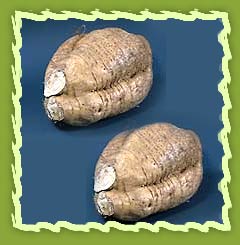Parts Offered
We are wholesale suppliers and exporters of :-
Arrowroot,
Arrowroot Powder,
Arrowroot
Fruits
Description
An erect slender branched herb, 90-180 cm high with fleshy cylindrical
obovoid rhizome covered with pale scales leaving scars on falling; leaves
ovate-oblong to ovate-lanceolate, base rounded or cuneate, tip acute,
flowers white in clusters on diverging inflorescence branches, fertile
stamen with appendage, ovary one-celled, one-ovuled.

Chemical Constituents
Moisture,crude protein, fat starch, dextrin and sugars, crude fibre and
ash.
Cosmetic Uses
Used in talcum powders and hair dyes. Added to moisturizers as a thickening
agent and to help active ingredients penetrate the upper levels of the skin.
Is used in cosmetics to help moisturizers penetrate the skin. A fine, white
powder. May have other uses similar to cornstarch.
A lovely, soft powder used to make our body powders silkier and smoother. A
very fine white cosmetic grade powder. May be mixed with cornstarch 1:3 to
provide an alternative and safer powder than talc. Has great
moisture-absorbing properties. Softens skin, absorbs moisture. In cosmetics
it is used to help moisturizers penetrate the skin, and to thicken water
based products. Arrowroot has long been used in biscuits and for making
clear glazes for fruit pies.
The powdered starch derived from tuberous rhizomes of the Maranita
arundinacea plant. Used in place of talc (which is synthetic) in making body
powders, arrowroot is light, soft and absorbent. It can also be used to help
dry up blemishes, rashes, or other sores or wounds.
An ingredient in dusting powders and hair dyes made from the root starch of
the plant. Arrowroot was used by American Indians to heal wounds from
poisoned arrows. No Known Toxicity.
Most often used as an ingredient in powders, this nutritious starch from
the root of the plant was used by aboriginal peoples to heal wounds from
poisoned arrows (thus the name). Non-toxic. Can also be used in the kitchen
for arrowroot cookies or as a tasty alternative to other starches,
especially in stir frys. Product of Thailand.
Arrowroot is made by grinding the thick rhizomes into a starchy powder that
is used as a culinary and cosmetic thickening agent or boiled in water to
make a thin gruel. This is a soothing, nutritious food for convalescing
children and elderly people, and for those recovering from gastroenteritis.
It is mixed with dried
chamomile
as a prickly heat treatment. The root can be candied as a sweet.
The rhizomes of this plant contain an edible starch, which is eaten widely
in the West Indies, South-East Asia and South Africa. Arrowroot can grow to
about 2 meters in height and is propagated from the tips of the rhizomes.
When the leaves have started to wilt, 10 to 12 months after planting, it is
dug up, its rhizomes removed, peeled and grated in water. The resultant
powder is dried but later purified again by several more washings. The
product is almost pure starch. It is used as a thickener for soups, sauces
and puddings, especially custards. It is especially easy to digest and is,
therefore, used in baby foods and diets for invalids.
TIPS
For baby powder, you can easily make your own, out of a blend of
cornstarch, arrowroot powder, and white cosmetic clay. You may either add a
few drops of
lavender
essentail oil, or some finely pulverized dried lavender buds or dried
rose
petals. If you choose to use the essential oils, sprinkle the few
drops it will take over the mixture of 'powders' and blend in with your
finger tips, then sift well.
Good, basic substitutes for talcum powder are cornstarch, arrowroot powder,
fuller's earth, or rice powder (especially for the face). Try these recipes
for making your own bath powder:
Light weight, white powder used as a base for body powder or thickening
agent in cooking. Provides an excellent, clear thickener. Can substitute
cornstarch (use a bit more; doesn't impart as glossy a finish), kuzu powder,
tapioca starch, potato starch, rice starch or flour.
Uses
Starch obtained from rhizome is astringent, sweet, refrigerant, tonic
aphrodisiac, emollient, expectorant, febrifuge and rubefacient. It is useful
in dysentery, diarrhoea, dyspepsia, bronchitis, cough and also as a
nourishing food for infants, invalids and convalescents. It is the main
ingredient in biscuits, cakes puddings, jellies and face powders.

